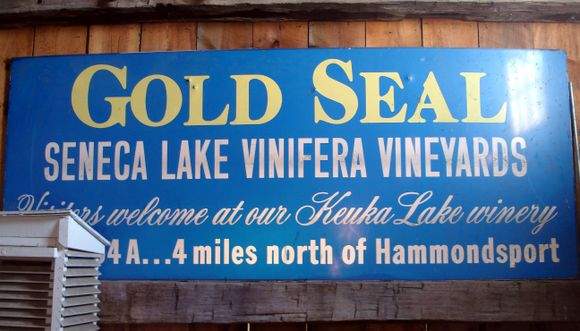
By Jason Feulner, Finger Lakes Correspondent
Standing Stone Vineyards is located on the southeastern shore of Seneca Lake in the so-called "banana belt" of the Finger Lakes. This stretch of lakefront, which encompasses several major and well-known wineries, is said by some winemakers to have temperatures that can sometimes range a few degrees warmer than the surrounding area, either enhancing ripening or staving off killer cold.
During a recent visit, I was surprised to learn that Standing Stone is at the every epicenter of this warm area. Tucked away in a barn sits an old sign that signifies a very rich history: "Gold Seal Seneca Lake Vinifera Vineyards."
"Yes, this was the spot," owner and winemaker Marti Macinski confirms. "This is where Guy DeVaux and Charles Fournier tested their grapes."
The story is part of Finger Lakes lore.
Back in the 1960s while Dr. Konstantin Frank experimented with vinifera on Keuka Lake, the Gold Seal Wine Company brought two Frenchmen, Guy DeVaux and Charles Fournier, to the Finger Lakes to determine whether vinifera could thrive in its cool climate with harsh winters. Experimental stations were set up all over the region and, eventually, the site where Standing Stone is located was selected by Gold Seal as having the most ideal growing conditions in the region.
Gold Seal purchased the property in 1969 and planted riesling and chardonnay in 1972. By the mid-1980's the property had changed hands several times during long and complicated transactions that sent the Gold Seal brand into oblivion. Marti Macinski and her husband Tom bought the property in 1991.
Standing Stone has over 41 acres under vine, and is most noteworthy for having the feel of a long-standing agricultural enterprise. The farm long predates Gold Seal's purchase of the land. There are barns and buildings everywhere, including an old farmhouse where the Macinski's live, and an old smokehouse as well.
 The view of the lake from the winery is also one of the nicest and most expansive I have seen.
The view of the lake from the winery is also one of the nicest and most expansive I have seen.
Despite Standing Stone's natural advantage in ripening grapes, the reds at the winery are not often the most cited of the winery's offerings. Marti is particularly proud of her pinot noir and Pinnacle (a cabernet-based blend), but she acknowledges that her ice wines draws a great deal of attention.
"Our 1999 vidal ice wine received an 89 from Wine Spectator and wide critical acclaim," Marti explains, "so we asked ourselves if we should make more. Then, in 2001 we got our first 90!"
While Standing Stone keeps the price of their ice wine under $30, Marti emphasizes that it is tough going. "The yield losses are enormous as the months stretch past the regular harvest. It's also a challenge to make ice wine because it's hard to keep fermentation going with such high sugars. Only a few yeasts work well, and they have to babied along. If you don't pay enough attention, the whole wine can become a microbiological mess."
Standing Stone has made wine from grapes frozen on the vine, but since a solid freeze is hard to come by until well into January or February the yield losses can be unacceptable. For the most part, Standing Stone commercially freezes their ice wine grapes in November and then presses them in the cold during January.
Marti Macinski is excited about the 2009 harvest that, while not warm or easy to manage in terms of mildew and other rain-related problems, has still provided some good fruit. "This vintage is going to demonstrate who the good growers are, because it's the type of year that you have to work your tail off. Not two days went by this year that I wasn't in the vineyard."
But, the vineyard is where Marti feels most comfortable. "Winemaking is one thing," she says, "but growing is the really interesting part for me." i
